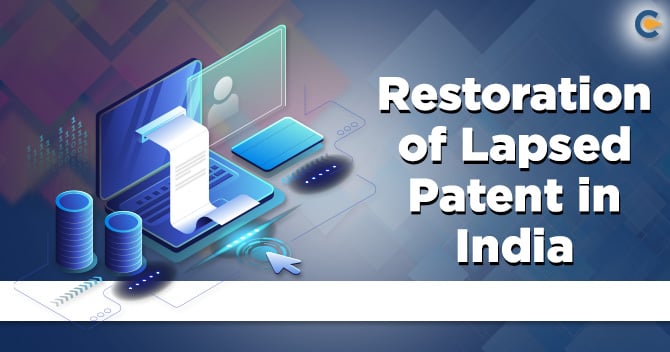In India, a Patent is granted for a term of 20 years from the date of filing of the Patent in the Indian Patent Office. As per Section 53 of Patent Act, 1970, the Patentee is required to pay a renewal fee till the date of possession given by the Indian Patent Office. If the holder of Patent does not pay the renewal or maintenance fees within the prescribed time limit given by the Indian Patent Office, such a Patent will lapse. The Patent Act, 1970, provides for provisions related to Restoration of Lapsed Patent in India. In the article, we will discuss the complete procedure of disposing of the application for the Restoration of Lapsed Patent in India.
What is the Restoration of Lapsed Patent in India?
The Patents Act, 1970, provides for certain safeguards for Restoration of Lapsed Patent in India. A patent which ceased to have effect because of a failure in payment of the prescribed fees within the period prescribed under Section 53 of the Patent Act, 1970[1], or within such time period, allowed under Section 142 of the Patent Act, 1970.
The Patentee, or the legal representative of Patentee, can make an application for the Restoration of Lapsed Patent in the manner prescribed manner in the Patent Act, 1970. In the circumstance where the Patent is held by two or more persons jointly, then with the permission of the Controller of Patent, one or more of the joint owners or without joining others can submit an application for Restoration of Lapsed Patent in India.
The application for Restoration should be filed within 18 months from the date on which the Patent ceases to have effect. However, any person can pay the renewal fees of the application for the Restoration of a Lapsed Patent in India. Still, the application of Restoration should be made by the Patentee himself/herself or by his/her legal representative. The application for Restoration of a Lapsed Patent can be made within one year from the date on which the Patent has lapsed.
What is the Effect of Non-Payment of Renewal Fees for a Patent?
To preserve a Patent for a prescribed term, a yearly renewal fee should be paid to the Patent Office by the Patentee. The renewal fees it is not paid by the Patentee in the specified time period, then the Patent lapses or ceases to have effect and becomes a property of the public even after availing Patent Registration successfully. The Patent Act, 1970, provides for provisions for Restoration of a Lapsed Patent in India.
Consequently, a Patent which ceases to have effect by reason of failure in payment of the prescribed renewal fees within the stipulated time period under Section 53 of the Patent Act, 1970, the Patentee or his legal representative can make an application for Restoration of Lapsed Patent in the prescribed manner. The Patent, if held by two or more persons jointly, then, with the permission of the Controller of Patent, one or more of the joint owners, without joining others, can submit the Restoration application. As per Section 60(1) of the Patent Act, 1970, the application for Restoration should be submitted within 18 months from the date on which the Patent lapsed or ceased to have effect.
What are the requirements for the Restoration of Lapsed Patent in India?
The essential requirements for Restoration of Lapsed Patent in India are as follows:
- According to Section 60 of the Patent Act, 1970, the application for the Restoration of Lapsed Patent should be made by the Patentee or his legal representative;
- The fees prescribed should be paid by the Patentee while filing Form 15;
- A proof to support that the failure of the renewal of Patent was unintentional from Patentee’s side should be submitted by the Patentee;
- The application of Restoration should include a statement to specify the circumstances which led to the delay in payment of the renewal fees. The statement of the Patentee should be supported by copies of documents referred to in the statement and evidences, if any;
- The evidence given by the Patentee should support the claim of failure for payment of renewal fee was unintentional from Patentee’s side;
- Further evidences can be called by the Controller of Patent, which includes deeds, letters;
- The Patentee cannot claim the failure was unintentional, if he/she purposely elects not to pay the renewal fees under an erroneous belief that he/she secures no advantage by paying the fees of renewal;
- The financial incapacity of the Patentee will not be admitted as a valid ground of unintentional failure for the payment of renewable fees;
- The Patentee who has to pay the renewal fee is generally the Patentee himself/herself, but maybe a licensee or agent of the Patentee;
- Consideration is only given to the last decision of Patentee before expiry of the stretched time limit for the payment of renewal fee under Section 53(2) of the Patent Act, 1970, in deciding whether the failure in payment of renewal fee was unintentional on the part of the Patentee. There is no attention paid to any previous changes in the mind of the Patentee;
- A Patentee should exercise reasonable diligence in preserving his/her Patent, it is not certainly satisfactory to claim innocence of undue delay, because he/she was uninformed of the lapsing Patent because of the fault of his/her ‘agent.’ To secure Restoration of a Lapsed Patent, a supporting evidence of proved negligence in the agent’s office will be sufficient;
- Though there is no extra fee for Patent of Addition, but the holder of Patent or the Patentee is required to submit each form individually for each additional Patent with that of the Parent Restoration of Lapsed Patent application.
Read our article:Procedure for Registration of Patent Agent in India
What is the Procedure for Disposal of application of Restoration of Lapsed Patent in India?
The procedure for disposal of application of Restoration of Lapsed Patent in India is as follows:
- After the submission of the application of the Restoration to the Controller of Patent, when the Controller is satisfied, the failure to pay the renewal fees was unintentional, and no undue delay was there, the Restoration application will be published in the official journal. {as per Section 61 of the Patent Act, 1970]
- The Controller of Patent is satisfied that there is no case of Restoration; he/she can issue a notice for the same to the applicant. The applicant should make a request of hearing on the matter within 1month from the date of notice. Afterward, a hearing should be held, and the application of Restoration should be disposed of by the Controller of Patent. The application of Restoration will be refused if no request of the hearing will be made by the applicant within 1 month from the date of the notice by the Controller of Patent. A speaking order is issued in case of rejection of the Restoration application by the Controller of Patent.
- Notice of Opposition can be given by any person, in the manner prescribed, to the applicant. The notice of opposition should be given within 2 months from the date of publication of Restoration application in the official journal.
- The Opposition notice should include a statement declaring the nature of the interest of the opponent, the opposition grounds, and the facts on which the opposition is relied upon. The Controller of Patent should expeditiously send the notice of opposition to the applicant.
- As per the Rule 57 to 63 of the Patent Rules, the provisions related to Post-Grant Opposition should apply.
- The Controller of Patent should allow the order for Restoration application, if no opposition is received within 2 months from the date of the publication of the Restoration application in the official journal. As prescribed in the First Schedule, the renewal fees and any additional fees should be paid by the applicant within one month from the date of the order of the Controller of Patent.
- The fact that Restoration of Lapsed Patent is done should be published in the official journal.
- The person who has already begun the use of the invention of the applicant in the time between the Patent was ceased and the date on which the Lapsed Patent was restored, the Controller can impose any order to protect and compensate the persons who were using the Patent. No suit or other proceeding will be started or prosecuted regarding an infringement of Patent committed between the date on which the Patent ceased to have effect, and the date of the publication of the Restoration application was made in the official journal.
What are the grounds for Opposition of the Restoration of Lapsed Patent in India?
After the hearing of the applicant in the case where the applicant himself/herself desires or on the request of Controller of Patent, the Controller if is prima facie satisfied that the payment of the renewal fees of the Patent was unintentional and no undue delay was made in making the application of Restoration of Patent, the Controller should publish the application of Restoration in the official journal in the prescribed manner and within the stipulated time period. Any person can file for the opposition for the Restoration of Patent.
The opposition can be given on both or any one of the following grounds:


There are no other grounds specifies for filing such an application of Opposition for the Restoration of Lapsed Patent in India. The person interested can only file for an application of the Restoration of Patent in India.
The notice of opposition is filed in Form 14, along with prescribed fees. The time period stipulated for filing of the opposition notice is 2 months from the date of publication of the application for Restoration of a Lapsed Patent in the official journal.
The Patent Act, 1970, and the Patent Rules, 2003, does not provide for any extension beyond the period of 2 months for filing the notice of opposition. Though, under Rule 138 of Patent Rules, 2003, a petition can be filled seeking extension of time beyond the 2 months’ time period with the prescribed fees for the same. The petition for extension of the time period should be filed within a period of 2 months only. The grant of extension of time period cannot be taken for granted by the applicant as the grant of the extension under Rule 138 of the Patent Rules, 2003, is the discretionary power of the Controller of Patent.
What are the Rights of Patentee of Lapsed Patent, which have been Restored?
After the Restoration of Lapsed Patent, the rights of the Patentee shall be subject to such provisions as may be prescribed by the Controller of Patent in his/her order and to such other provisions as he/she thinks appropriate to enforce for the protection of compensation of the persons who might have begun to avail them from the invention of the Patent between the date when the Patent ceases to have effect and the date of publication of the Restoration application in the official journal.
The Patentee of the invention loses his/her right in the Patent, and the invention becomes a public property, after the Patent is lapsed due to non-payment of the renewal fees of the Patent. Section 62 of the Patent Act, 1970, provides for provisions for safeguarding the interests of those people who after establishment from the Register of Patents that the Patent has ceased to exist or has lapsed due to non-payment of the renewal fees and has become public property and the people had started the commercial use of the invention. There can be no suit or proceedings of Patent Infringement will be prosecuted against the persons who began the use of the Patent between the time of when the Patent Lapsed and the date on which the Restoration of Patent was done.
Conclusion
After the submission of all documents, the Restoration of the Lapsed Patent is not a given possibility on filing of the application of Restoration. The Controller of Patent does the examination of the information provided by the holder of Patent for the Restoration of Patent. If the Controller of Patent is convinced that the supporting evidences that non-payment of renewal fees by the Patentee was unintentional and no undue delay was there in making the Restoration application, the application of Restoration along with the original Patent will be published in the official journal as per Rule 84(3) of the Patent Rules.
Restoration of a Lapsed Patent comprises of several partial verdicts that are to be taken by the Controller of Patents. Therefore, Patentees are suggested to be very attentive about the deadlines of the renewal of Patent. The process of Restoration of Lapsed Patent is long-lasting and lengthy. We at Corpbiz have experienced professionals to guide you with the process. Our professional will help and assist you throughout the process of Restoration. Our professionals will ensure the successful and timely completion of your work.
Read our article: Patent Opposition in India: Complete Procedure











